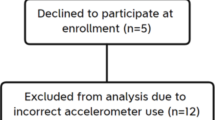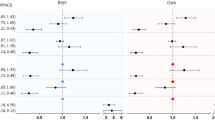Abstract
Background:
Young adults born preterm have higher levels of cardio metabolic risk factors and they report less physical activity than their peers born at term. Physical activity provides important cardio metabolic health benefits. We hypothesized that objectively measured physical activity levels are lower and time spent sedentary is higher among preterm-born individuals compared with controls.
Methods:
We studied unimpaired participants of the ESTER birth cohort study at age 23.3 y (SD: 1.2): 60 born early preterm (<34 wk), 108 late preterm (34–36 wk), and 178 at term (controls). Physical activity and sedentary time were measured by hip-worn accelerometer (ActiGraph).
Results:
As compared with controls’ (mean physical activity, 303 counts per minute (cpm; SD 129)), physical activity was similar among adults born early preterm (mean difference = 21 cpm, 95% CI −61, 19) or late preterm (5 cpm, −27, 38). Time spent sedentary was also similar. Adjustments for early life confounders or current mediating characteristics did not change the results.
Conclusion:
In contrast to our hypothesis, we found no difference in objectively measured physical activity or time spent sedentary between adults born preterm and at term. The previously reported differences may be limited to physical activity captured by self-report.
Similar content being viewed by others
Log in or create a free account to read this content
Gain free access to this article, as well as selected content from this journal and more on nature.com
or
References
Burns YR, Danks M, O’Callaghan MJ, et al. Motor coordination difficulties and physical fitness of extremely-low-birthweight children. Dev Med Child Neurol 2009;51:136–42.
Kajantie E, Strang-Karlsson S, Hovi P, et al. Adults born at very low birth weight exercise less than their peers born at term. J Pediatr 2010;157:610–6, 616.e1.
Kaseva N, Wehkalampi K, Strang-Karlsson S, et al. Lower conditioning leisure-time physical activity in young adults born preterm at very low birth weight. PLoS One 2012;7:e32430.
Rogers M, Fay TB, Whitfield MF, Tomlinson J, Grunau RE. Aerobic capacity, strength, flexibility, and activity level in unimpaired extremely low birth weight (<or=800 g) survivors at 17 years of age compared with term-born control subjects. Pediatrics 2005;116:e58–65.
Johansson S, Iliadou A, Bergvall N, Tuvemo T, Norman M, Cnattingius S. Risk of high blood pressure among young men increases with the degree of immaturity at birth. Circulation 2005;112:3430–6.
Kajantie E, Hovi P. Is very preterm birth a risk factor for adult cardiometabolic disease? Semin Fetal Neonatal Med 2014;19:112–7.
Martin JA, Osterman MJ ; Centers for Disease Control and Prevention (CDC). Preterm births - United States, 2006 and 2010. MMWR Suppl 2013;62:136–8.
Sipola-Leppänen M, Vääräsmäki M, Tikanmäki M, et al. Cardiometabolic risk factors in young adults who were born preterm. Am J Epidemiol 2015;181:861–73.
Tikanmäki M, Tammelin T, Sipola-Leppänen M, et al. Physical fitness in young adults born preterm. Pediatrics 2016;137:1–10.
Hamilton MT, Healy GN, Dunstan DW, Zderic TW, Owen N. Too little exercise and too much sitting: inactivity physiology and the need for new recommendations on sedentary behavior. Curr Cardiovasc Risk Rep 2008;2:292–8.
Nocon M, Hiemann T, Müller-Riemenschneider F, Thalau F, Roll S, Willich SN. Association of physical activity with all-cause and cardiovascular mortality: a systematic review and meta-analysis. Eur J Cardiovasc Prev Rehabil 2008;15:239–46.
Kaseva N, Martikainen S, Tammelin T, et al. Objectively measured physical activity in young adults born preterm at very low birth weight. J Pediatr 2015;166:474–6.
Welsh L, Kirkby J, Lum S, et al.; EPICure Study Group. The EPICure study: maximal exercise and physical activity in school children born extremely preterm. Thorax 2010;65:165–72.
Hildebrand M, Kolle E, Hansen BH, et al. Association between birth weight and objectively measured sedentary time is mediated by central adiposity: data in 10,793 youth from the International Children’s Accelerometry Database. Am J Clin Nutr 2015;101:983–90.
Järvelin MR, Hartikainen-Sorri AL, Rantakallio P. Labour induction policy in hospitals of different levels of specialisation. Br J Obstet Gynaecol 1993;100:310–5.
Sipola-Leppänen M, Vääräsmäki M, Tikanmäki M, et al. Cardiovascular risk factors in adolescents born preterm. Pediatrics 2014;134:e1072–81.
Miettola S, Hartikainen AL, Vääräsmäki M, et al. Offspring’s blood pressure and metabolic phenotype after exposure to gestational hypertension in utero. Eur J Epidemiol 2013;28:87–98.
Vääräsmäki M, Pouta A, Elliot P, et al. Adolescent manifestations of metabolic syndrome among children born to women with gestational diabetes in a general-population birth cohort. Am J Epidemiol 2009;169:1209–15.
Pihkala J, Hakala T, Voutilainen P, Raivio K. [Characteristic of recent fetal growth curves in Finland]. Duodecim 1989;105:1540–6.
Matthews CE, Ainsworth BE, Thompson RW, Bassett DR Jr . Sources of variance in daily physical activity levels as measured by an accelerometer. Med Sci Sports Exerc 2002;34:1376–81.
Haskell WL, Lee IM, Pate RR, et al. Physical activity and public health: updated recommendation for adults from the American College of Sports Medicine and the American Heart Association. Med Sci Sports Exerc 2007;39:1423–34.
Mutikainen S, Helander E, Pietilä J, Korhonen I, Kujala UM. Objectively measured physical activity in Finnish employees: a cross-sectional study. BMJ Open 2014;4:e005927.
Jaakkola JJ, Ahmed P, Ieromnimon A, et al. Preterm delivery and asthma: a systematic review and meta-analysis. J Allergy Clin Immunol 2006;118:823–30.
Strang-Karlsson S, Räikkönen K, Pesonen AK, et al. Very low birth weight and behavioral symptoms of attention deficit hyperactivity disorder in young adulthood: the Helsinki study of very-low-birth-weight adults. Am J Psychiatry 2008;165:1345–53.
Steene-Johannessen J, Anderssen SA, van der Ploeg HP, et al. Are self-report measures able to define individuals as physically active or inactive? Med Sci Sports Exerc 2016;48:235–44.
Prince SA, Adamo KB, Hamel ME, Hardt J, Connor Gorber S, Tremblay M. A comparison of direct versus self-report measures for assessing physical activity in adults: a systematic review. Int J Behav Nutr Phys Act 2008;5:56.
Sofi F, Capalbo A, Cesari F, Abbate R, Gensini GF. Physical activity during leisure time and primary prevention of coronary heart disease: an updated meta-analysis of cohort studies. Eur J Cardiovasc Prev Rehabil 2008;15:247–57.
Chastin SF, Egerton T, Leask C, Stamatakis E. Meta-analysis of the relationship between breaks in sedentary behavior and cardiometabolic health. Obesity (Silver Spring) 2015;23:1800–10.
Ekelund U, Ward HA, Norat T, et al. Physical activity and all-cause mortality across levels of overall and abdominal adiposity in European men and women: the European Prospective Investigation into Cancer and Nutrition Study (EPIC). Am J Clin Nutr 2015;101:613–21.
Biswas A, Oh PI, Faulkner GE, et al. Sedentary time and its association with risk for disease incidence, mortality, and hospitalization in adults: a systematic review and meta-analysis. Ann Intern Med 2015;162:123–32.
Celis-Morales CA, Perez-Bravo F, Ibañez L, Salas C, Bailey ME, Gill JM. Objective vs. self-reported physical activity and sedentary time: effects of measurement method on relationships with risk biomarkers. PLoS One 2012;7:e36345.
Kaseva N, Martikainen S, Tammelin T, et al. Objectively measured physical activity in young adults born preterm at very low birth weight. J Pediatr 2015;166:474–6.
Kaczynski AT, Manske SR, Mannell RC, Grewal K. Smoking and physical activity: a systematic review. Am J Health Behav 2008;32:93–110.
Acknowledgements
We are grateful to all the participants for their contribution in the ESTER Study. We also thank research nurses Katriina Inget, Sinikka Kursu, Hanna-Maria Matinolli, Liisa Saarikoski, Marjatta Takala, Sarianna Vaara, data manager Sigrid Rosten, research assistants Risto Karvonen, Petteri Koivurova, Antti Koskela, Sanna Mustaniemi, Heli-Kaisa Saarenpää, and Marja Vanhatalo from the National Institute of Health and Welfare, Oulu and Helsinki, Finland, as well as statistician Anna Kankaanpää from LIKES Research Center for Physical Activity and Health, Jyväskylä, Finland.
Author information
Authors and Affiliations
Corresponding author
PowerPoint slides
Rights and permissions
About this article
Cite this article
Tikanmäki, M., Tammelin, T., Kaseva, N. et al. Objectively measured physical activity and sedentary time in young adults born preterm—The ESTER study. Pediatr Res 81, 550–555 (2017). https://doi.org/10.1038/pr.2016.262
Received:
Accepted:
Published:
Issue date:
DOI: https://doi.org/10.1038/pr.2016.262
This article is cited by
-
Adults born preterm have lower peripheral skeletal muscle area and strength
Scientific Reports (2024)
-
Sports participation and preterm birth: a nationwide birth cohort in Japan
Pediatric Research (2022)



